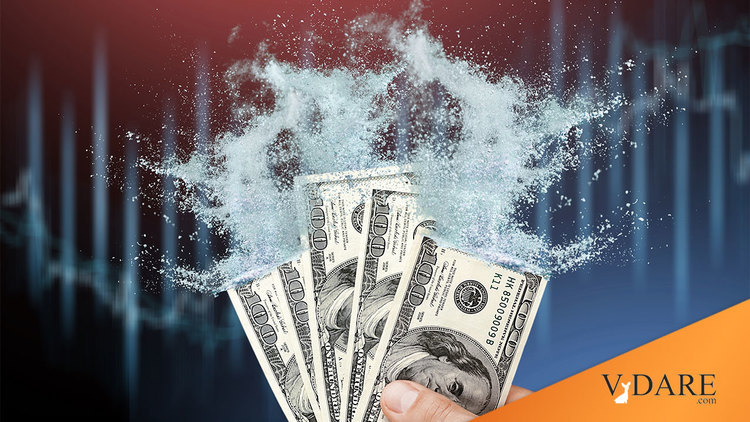
Where Inflation Came From
10/19/2008
Anyone who has been alive very long is aware that the US government has failed on the inflation front. Soft drink machines that once delivered a bottled drink for a nickel now charge a dollar, a twenty- fold increase in price.
Until the Reagan administration indexed the income tax, inflation was a boon to government, because by pushing up wages and salaries inflation pushed taxpayers into higher brackets. This allowed the real tax burden on labor to rise without politicians having to raise the tax rates. Inflation also destroyed the value of depreciation allowances, thus raising the tax rate on capital as well.
It is not easy to make the young aware of the long-term rise in prices. The inflation indices are periodically re-based, resulting in measures over time with different years as the base. The Clinton administration further destroyed comparability by substituting a variable basket of goods for the fixed assortment that had previously prevailed. With the Boskin Commission "reform" adopted by the Clinton administration, the Consumer Price Index (CPI) no longer compares apples to apples. If the price of apples rises, the CPI assumes that consumers switch to a cheaper substitute. The "substitution effect" tthus underestimates the rate of inflation and destroys the comparability of the inflation rate from one period to the next.
Inflation is inherent in a fractional reserve banking system based on fiat money. Fiat money is not subject to limits on its supply, and fractional reserve banking permits the banking system to create money by expanding loans.
Aware of the ever present threat of inflation from such a system, Milton Friedman advocated a monetary rule that would limit the growth of the money supply to the long-term growth rate of the economy. For example, if the money supply grew 2 to 3 percent annually in keeping with the increase in real output, prices would remain stable. Perhaps it wasn’t a perfect solution, but at least Friedman thought about the problem.
In the post-WW II period, the US has experienced dramatic increases in the growth of money and credit. One way to demonstrate the erosion of the purchasing power of money is to look at the change in the behavior of the prices of used Ferraris. In the 1950s, 1960s, and even the 1970s, Ferraris depreciated rapidly. Well-to-do playboys attracted by the unique cars wanted the latest model, and few other people wanted the maintenance expense associated with the high performance machines. It was not out of the question for a person with an ordinary income to become the second owner of a Ferrari. Excepting a few models of high volume and undistinguished performance, today it is totally out of the question that a person lacking an out- sized income or a large inheritance could acquire a previously owned Ferrari.
For example, in 1973 when I left Stanford University I had an opportunity to purchase a 1967 Ferrari 330 GTS. It was a low mileage car in new condition. The asking price was $10,000 and could have been negotiated down. Unfortunately, the Scottish part of my ancestry prevailed, and I did not purchase the Ferrari. Recently at the Monterey auction a 330 GTS sold for $671,000, 67 times its 1973 used car price.
As an assistant professor of economics in 1967, I cut a road test out of Road & Track magazine and filed it. The test was one of a 1967 Ferrari 275 GTB/4. The new price was $14,500. I intended to find onein a few years at a substantially depreciated price. At a recent Monetary auction, a 1967 GTB/4 sold for $1,925,000.
What has happened to money that causes a 41-year-old used car to sell for 133 times its new car price?
The abundance of money from a fiat money/fractional reserve banking system raises the price of scarce items that are beautiful and unique, such as Ferraris and antiques. Few Ferrari models were produced in numbers greater than several hundred cars. Perhaps the most famous Ferrari is the 250 GTO. Less than 40 were produced. The GTO, which is street legal, dominated racing and won the World Manufacturers Championship in 1962, 1963, and 1964. The new car price was $18,000. In 1989 one sold for $13 million, This year one sold for $28 million. I have a friend who bought a used GTO in Europe in the mid-1960s for $9,000 and sold it six months later for the same price.
Ferraris became collectibles, a store of value, a role that the dollar no longer performs. Today collectible cars have become items for speculation. They are flipped in auctions with bids rising several hundred thousand dollars from auction to auction, just as real estate speculators bid up waterfront condo prices and hedge funds bid up oil futures contracts.
The cars are worth so much now that you will never see one on the road, not even in the playgrounds of the rich and famous. The more than 1,500-fold rise in the price of the GTO over the last 45 years makes gold’s 28-fold price rise seem insignificant. But both prices show the ruin inflicted on the dollar by our fiat money/fractional reserve system.
Paul Craig Roberts was Assistant Secretary of the Treasury during President Reagan’s first term. He was Associate Editor of the Wall Street Journal. He has held numerous academic appointments, including the William E. Simon Chair, Center for Strategic and International Studies, Georgetown University, and Senior Research Fellow, Hoover Institution, Stanford University. He was awarded the Legion of Honor by French President Francois Mitterrand. He is the author of Supply-Side Revolution : An Insider’s Account of Policymaking in Washington; Alienation and the Soviet Economy and Meltdown: Inside the Soviet Economy, and is the co-author with Lawrence M. Stratton of The Tyranny of Good Intentions : How Prosecutors and Bureaucrats Are Trampling the Constitution in the Name of Justice. Click here for Peter Brimelow’s Forbes Magazine interview with Roberts about the recent epidemic of prosecutorial misconduct.
